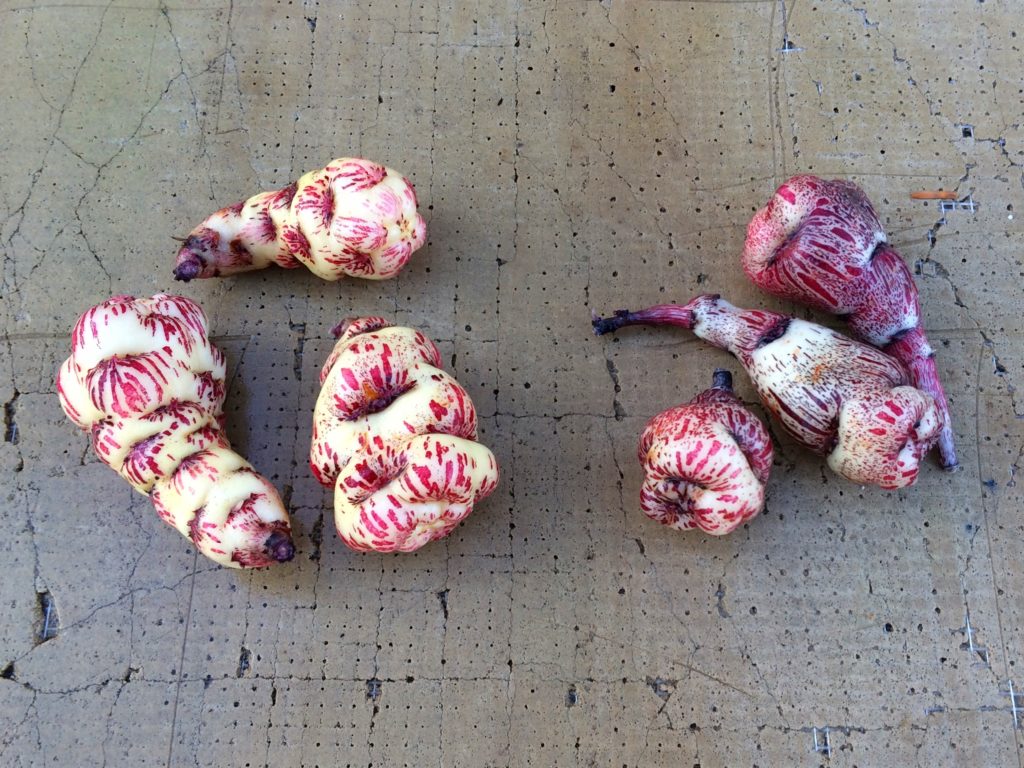No products in the cart.
Blog, genetics, mashua (Tropaeolum tuberosum)
Mashua: Tetraploid Variability
The domesticated varieties of mashua (Tropaeolum tuberosum) are tetraploid, meaning that they have four copies of each chromosome. This allows the plant to carry twice the genetic diversity of a diploid organism (like most animals and many plants). Balanced against that, mashua is most likely an autoploid, meaning that it became tetraploid by doubling its own genome, rather than hybridizing with a related species, which would result in an alloploid. Because the mashua genome has doubled without incorporating the genome of any other species, the potential for containing a lot of additional genetic diversity is somewhat reduced. It is kind of like adding a second hard drive to your computer and using it to make a duplicate of your existing drive. At first, they are the same, but if you don’t keep duplicating, the data contained on each drive will diverge over time. Over a long period of time, mutations will accumulate and crossing between varieties will diversify what was originally two copies of the same genome, but I wouldn’t expect the process of genetic diversification to be as fast as it would be in an allopolyploid like oca (Oxalis tuberosa), which was formed by the fusion of three different genomes.
Mashua self-pollinates readily and almost exclusively without intervention. For the breeder, this is a bit of a nuisance. Emasculating and hand pollinating mashua flowers is not difficult, but it has a fairly low rate of success. I spend most of my time making crosses between varieties, but last year I had the chance to collect some seeds from an isolated plant of mashua ‘Blanca’ growing in my mom’s garden. I grew out a bunch of the seeds this year to get a sense for how much variability might be revealed in self-pollinated mashua seedlings. I anticipated that the variability would be pretty minimal because the progeny of crosses between any two mashua varieties are all quite similar to one another, which suggests that the parents have fairly low genetic diversity.
Here is a picture of 12 of the seedlings selected from a batch of almost 60. These are representative of all of the phenotypes found in this batch:
As you can see, the level of diversity is not particularly high. If I didn’t have them separated by seedling, you might not even realize that they were different from one another. The differences are primarily in color. Most have white skin, with a few more yellow. Most have purple eyes and a few pink. I’m not sure if these are different pigments or just different concentrations, but the way different tubers grade into very light purple or very light pink makes me think that there are at least two different pigments involved. The amount of color in the eyes varies considerably. Some varieties are yellow at the tips and I know from experience that they will become much more yellow from exposure to light. The top right seedling stands out as having a more obovate shape, which is usually associated with larger tubers. I might keep that one to trial next year. Most of these will just be eaten, as they promise nothing that the parent variety doesn’t already have.

This has helped to confirm that I am not very interested in growing out self-pollinated mashua seeds. I’m interested primarily in new combinations of traits, not recreating existing varieties. That said, at least in the case of this variety, it would not be too difficult to reselect the parent traits from even a fairly small batch of self-pollinated seeds. That means that mashua germplasm could probably be stored effectively as seed and that similar varieties could be selected from seed in countries where importing tubers isn’t possible. So, while it is probably not much use for breeding, self-pollinated seed could be useful for conservation.
The above is an example of sexual diversification, but sometimes fortune also turns up a bit of somatic diversification. This year, I found an interesting mutant of Ken Aslet mashua. The picture is, unfortunately, not very good, but Ken Aslet is yellow and red, while the mutant is white and red. In person, the difference is more apparent. When I pulled up this plant, about two thirds of the tubers were the normal yellow color and one third were white. Most likely, there was a mutation in a meristem early on this year and all the tubers from stolons that branched off that stem carried the mutation. I’m not sure if it is really worth keeping, but Ken Aslet is such a popular variety that I will probably grow a test batch next year to see how it does.


The somaclonal mutant is beautiful, by the way. I like its looks more than the original Ken Aslet actually.
On the other subject, I like the idea of long term storage and sharing of self-pollinated seeds. I like it a lot.
The Ken Aslet mutation appears to have only 1/3 as many eyes. Maybe this would be easier to clean?